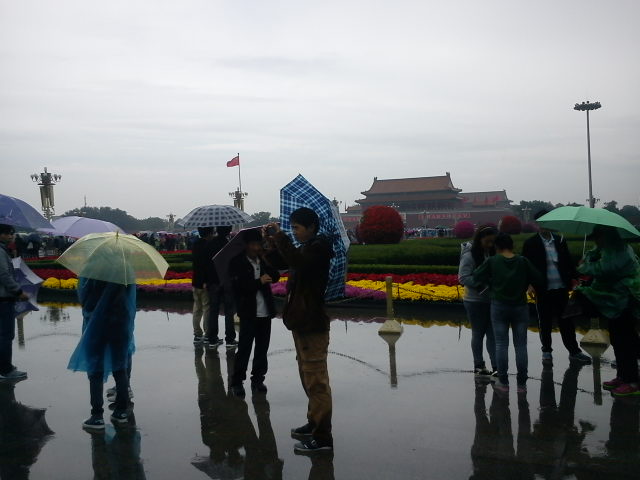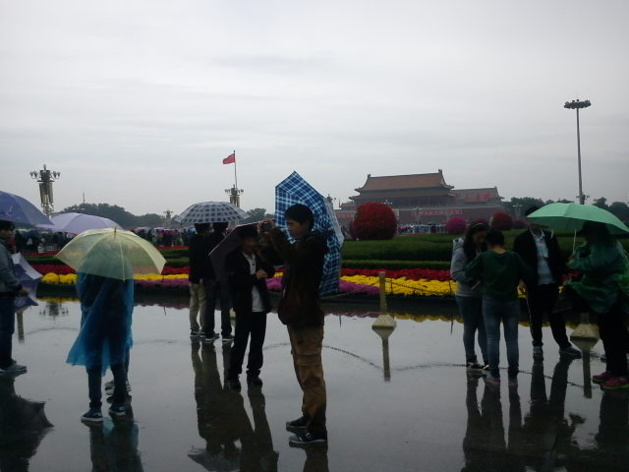The Chinese ‘ability’ to influence the weather was previously demonstrated during the 2008 Beijing Olympic Games, when meteorologists working for the Beijing Weather Modification Office of China used radars to hunt heavy rain clouds, which were then shot at with chemicals to make them rain and disperse out of sight of the city centre. Chinese authorities were mainly concerned about the rain extinguishing the Olympic Flame during the opening ceremony – which would have been catastrophic especially given the political significance that China continues to attribute to having hosted the Olympic Games. There were no significant rainfalls disrupting the opening ceremony, nor was there rain on the in the afternoon of national day when all the speeches started. Instead on Tiananmen Square promotional videos were played showcasting on big flat screens the ‘Best of Beijing 2008’ featuring world records, Chinese victories, intercultural dialogue and most of all: blue skies.
In the 1940s and 50s, the United States pioneered the cloud seeding technique that was employed during the Olympics in Beijing to influence the weather. During the Olympics, there were 20 firing sites around Beijing including, for example, the Fragrant Hills in the West, from were small rockets containing silver iodide were fired on heavy clouds to prevent a potential image disaster at the opening ceremony. This procedure then causes water particles in the clouds to collect around the iodides until the cloud gets too heavy and starts to rain. China started cloud seeding as early as 1958 to try to secure more water supplies.
There are two main ways of cloud seeding – one as mentioned above targets clouds from the ground, while the other one involves aircrafts directly injecting releasing agents into the cloud. Meteorologists differentiate between hygroscopic (clouds between 0 and 32°C) and glaciogenic seeding (clouds between -10 and -25°C), which both attempt to encourage crystallization within the cloud. China mostly uses ground-based seeding for cost reasons.
In the 1940s and 50s, the United States pioneered the cloud seeding technique that was employed during the Olympics in Beijing to influence the weather. During the Olympics, there were 20 firing sites around Beijing including, for example, the Fragrant Hills in the West, from were small rockets containing silver iodide were fired on heavy clouds to prevent a potential image disaster at the opening ceremony. This procedure then causes water particles in the clouds to collect around the iodides until the cloud gets too heavy and starts to rain. China started cloud seeding as early as 1958 to try to secure more water supplies.
There are two main ways of cloud seeding – one as mentioned above targets clouds from the ground, while the other one involves aircrafts directly injecting releasing agents into the cloud. Meteorologists differentiate between hygroscopic (clouds between 0 and 32°C) and glaciogenic seeding (clouds between -10 and -25°C), which both attempt to encourage crystallization within the cloud. China mostly uses ground-based seeding for cost reasons.
A controversial measure
Yet, it is controversial to what extent cloud busting can really influence the weather. In 2003, the United States National Academy of Sciences declared that in 30 years of research, there had not been enough evidence produced to proof that weather modification worked. Conversely, national governments still place their hopes in cloud busting as, for example, the Indonesian government promised to seed clouds in response to Singapore’s complaints about the haze clouds caused by Indonesian landowners’ slash-and-burn. Notwithstanding the controversy, China seems to continue to believe that cloud seeding can increase rainfall. Besides the question of whether or not cloud seeding has any effect, the implications chemically triggered rain has for the environment also need to be considered. In this context, wrong concentrations can seriously disrupt the ecosystems by producing too large hailstones that can harm flora and fauna. Overall, artificially produced rain and smog form both part of the challenge, environmental pollution poses to Beijing.
Additionally, there is a possible connection between rain and a drop in air pollution. On 1 October, Chinese National Day, it rained in the morning. Later in the day the sky was blue for once over Tiananmen, air pollution having fallen by 80 points from 182 to 102 micrograms per cubic metre on the PM 2.5 between 9 and 10am, reaching a low of 42 by 3pm. The ‘safe’ limit lies according to the Wold Health Organisation at 25 micrograms. The PM2.5 measure detects airborne pollutants smaller than 2.5 micrometers in diameter, which can penetrate the blood stream and the lungs. The readings indicate that the rain might have had contributed to the drop in the overall pollution levels.
Although the Chinese government showed awareness of environment issues in committing to spend 100 billion Yuan over the next three years to deal with the air pollution in Beijing in addition to promising to consider passing legislation that would limit the number of cars on the streets, the ultimately success of these attempts is still written in the stars. Last January, Beijing experienced one of the worst pollution crises in its history when the pollution rose to over 850 micrograms per cubic metre on the US embassy pollution rating. Breathing masks and air purifier sales skyrocketed, while public discontent with the government was boiling. Even state newspapers expressed relatively openly their discontent running editorials like ‘How can we get out of this suffocating pollution?’ The pollution crisis, therefore, caused a lot of negative press for China – not just internationally but also domestically.
If the government wants to prevent the recurrence of a similar situation this winter, it should aim to be better prepared this year. According to city officials, the forecast for 22 October exceeded 300microgram per cubic metre on the PM2.5. In response to the forecast, the city government has taken preventive action and announced a number of emergency measure last implemented during the Olympics. Among them are mandatory factory closures and the halting of excavation on construction sites, while private vehicles will only be allowed to operate on alternating days – depending on their license plate number. Yet, while it is good that the city government acknowledges that something has to be done about pollution, it would be much better if it took positive action and coordinated its efforts beyond the municipal level.
Most of the pollution in Beijing stems from the surrounding areas, where factories produce pollutants that contaminate the air. Although the national government has recently established a list of the top ten most-air-polluted cities, the extent to which such naming and shaming will be effective is questionable. Smog, for example, led to the closure of the Harbin International Airport as well as schools and kindergartens in Harbin on 21 October. It was blamed on the coal-fired heating system and farmers burning straw as temperatures are starting to drop. Yet, if we consider that factories in other municipalities such as Inner Mongolia significantly contribute to the smog crises, we have to seriously question the Chinese government’s list. If rainmaking was not as expensive (and controversial in its modus operandi) – maybe it would be a more appropriate response than writing lists – at least it would not play down the problem to a municipal level, when in truth it reaches way beyond national boarders.
Lire cet article en français
Additionally, there is a possible connection between rain and a drop in air pollution. On 1 October, Chinese National Day, it rained in the morning. Later in the day the sky was blue for once over Tiananmen, air pollution having fallen by 80 points from 182 to 102 micrograms per cubic metre on the PM 2.5 between 9 and 10am, reaching a low of 42 by 3pm. The ‘safe’ limit lies according to the Wold Health Organisation at 25 micrograms. The PM2.5 measure detects airborne pollutants smaller than 2.5 micrometers in diameter, which can penetrate the blood stream and the lungs. The readings indicate that the rain might have had contributed to the drop in the overall pollution levels.
Although the Chinese government showed awareness of environment issues in committing to spend 100 billion Yuan over the next three years to deal with the air pollution in Beijing in addition to promising to consider passing legislation that would limit the number of cars on the streets, the ultimately success of these attempts is still written in the stars. Last January, Beijing experienced one of the worst pollution crises in its history when the pollution rose to over 850 micrograms per cubic metre on the US embassy pollution rating. Breathing masks and air purifier sales skyrocketed, while public discontent with the government was boiling. Even state newspapers expressed relatively openly their discontent running editorials like ‘How can we get out of this suffocating pollution?’ The pollution crisis, therefore, caused a lot of negative press for China – not just internationally but also domestically.
If the government wants to prevent the recurrence of a similar situation this winter, it should aim to be better prepared this year. According to city officials, the forecast for 22 October exceeded 300microgram per cubic metre on the PM2.5. In response to the forecast, the city government has taken preventive action and announced a number of emergency measure last implemented during the Olympics. Among them are mandatory factory closures and the halting of excavation on construction sites, while private vehicles will only be allowed to operate on alternating days – depending on their license plate number. Yet, while it is good that the city government acknowledges that something has to be done about pollution, it would be much better if it took positive action and coordinated its efforts beyond the municipal level.
Most of the pollution in Beijing stems from the surrounding areas, where factories produce pollutants that contaminate the air. Although the national government has recently established a list of the top ten most-air-polluted cities, the extent to which such naming and shaming will be effective is questionable. Smog, for example, led to the closure of the Harbin International Airport as well as schools and kindergartens in Harbin on 21 October. It was blamed on the coal-fired heating system and farmers burning straw as temperatures are starting to drop. Yet, if we consider that factories in other municipalities such as Inner Mongolia significantly contribute to the smog crises, we have to seriously question the Chinese government’s list. If rainmaking was not as expensive (and controversial in its modus operandi) – maybe it would be a more appropriate response than writing lists – at least it would not play down the problem to a municipal level, when in truth it reaches way beyond national boarders.
Lire cet article en français





























